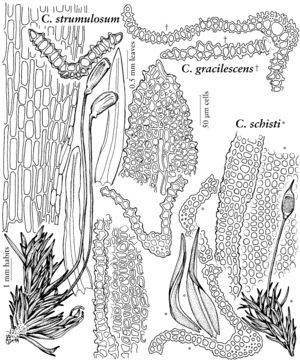Cynodontium schisti
Öfvers. Kongl. Vetensk.-Akad. Förh. 21: 230. 1864,.
Stems 0.4–0.8 (–1) cm. Leaves 1.5–1.8 (–2) mm, ovatelanceolate to linear-lanceolate, acute, sharply pointed at the apex; margins flat or partially narrowly recurved, 2-stratose; distal laminal cells strongly mammillose-papillose on both surfaces, thin-walled, rounded to quadrate to irregular, 8–9 µm wide. Perigonium stalked. Seta 0.2–0.3 (–0.4) cm, straight, wet or dry. Capsule straight and erect, striate, not strumose; annulus weakly developed.
Phenology: Capsules mature spring.
Habitat: Rock crevices, soil over rock
Elevation: moderate elevations
Distribution

Greenland, Alta., B.C., Nfld. and Labr. (Nfld.), Nunavut, Ont., Que., Sask., Yukon, Alaska, Colo., Maine, Mich., Mont., N.C., S.Dak., Wis., Wyo., Eurasia
Discussion
Cynodontium schisti is distinctive in having undivided peristome teeth that may be perforated. Cynodontium alpestre and C. glaucescens are reported also with poorly divided teeth, commonly divided in the distal 1/4 or to near the middle, whereas all other species of the genus have teeth typically divided to the middle or reaching to nearly the base. If the division of the peristome is part of a transformation series involving Cynodontium and the segregate Cnestrum, then Cynodontium schisti would represent the end-member, with peristome undivided. The operculum is only obliquely conical, rather than the long-rostrate operculum typical of Cynodontium. The cell lumen shape in leaf cross sections is more regularly quadrate rather than distorted-mammillose, and the cells generally have the low, rounded papillae of papillose mosses such as those of the Pottiaceae. The presence of similar quadrate (nonmammillose) lumina in section in C. alpestre and C. glaucescens should be looked for.
Selected References
None.
